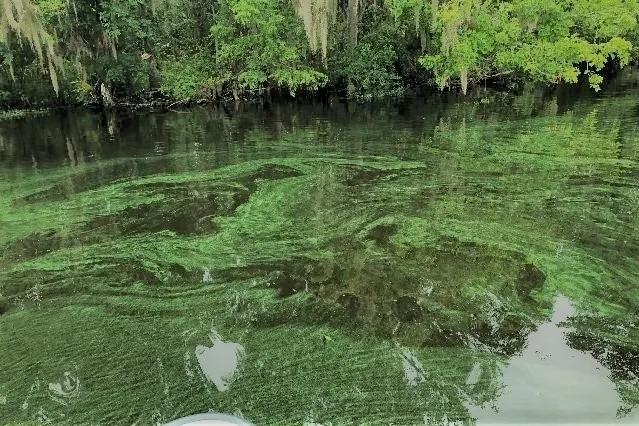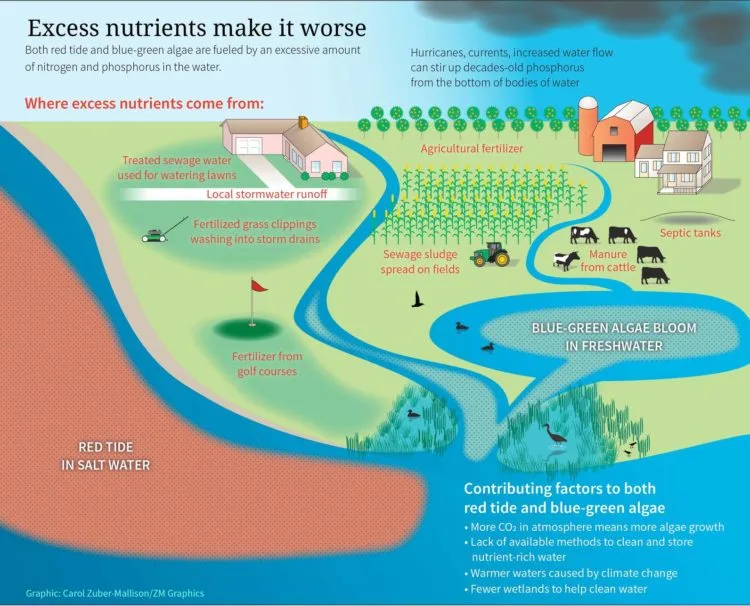The U.S. Army Corp of Engineers began discharging water from Lake Okeechobee into the Caloosahatchee and St. Lucie estuaries in mid-February. These annual discharges are intended to manage lake levels ahead of Florida’s rainy season, and they often result in blue-green algae growth in coastal estuaries.
News Reports
- Another blue-green algae health alert issued along Caloosahatchee, WGCU, 4/27/2024
- ‘It’s disgusting:’ Pahokee visitors react to algae bloom in marina, WPTV-5, 4/14/2024

Latest blue-green algae sampling
Update from the Florida Department of Environmental Protection (DEP)
Scroll for definitions of terms
April 19 – April 25, 2024 – There were 26 reported site visits in the past seven days with 26 samples collected. Algal bloom conditions were observed by samplers at 13 of the sites.
The satellite imagery for Lake Okeechobee from 4/25 shows low to moderate bloom potential on approximately 50% of the lake, mostly along the shorelines and in the northern half of the lake.
The satellite imagery for the Caloosahatchee Estuary from 4/25 shows scattered low bloom potential in the upper estuary.
The satellite imagery for the St. Lucie Estuary from 4/25 shows no visible bloom potential.
The satellite imagery for the St. Johns River from 4/24 shows scattered low bloom potential from Lake George downstream to the city of Jacksonville.
Please keep in mind that bloom potential is subject to change due to rapidly changing environmental conditions or satellite inconsistencies (i.e., wind, rain, temperature or stage.)
On 4/22 – 4/25, Florida Department of Environmental Protection (DEP) staff collected eight harmful algal bloom (HAB) response samples. Dominant algal taxa and cyanotoxin results follow each waterbody name.
Lake Minnehaha – East Dock: No dominant algal taxon; no cyanotoxins detected.
Lake Pearl – Park Dock: Microcystis aeruginosa; no cyanotoxins detected.
Lake Tarpon – Anderson Park: Microcystis aeruginosa and Cylindrospermopsis raciborskii co-dominant; no cyanotoxins detected.
Caloosahatchee River – North Canal Circle: No dominant algal taxon; trace level [0.34 parts per billion (ppb)] microcystins detected.
Lake Buckeye – Ramp: Microcystis sp. and Dolichospermum circinale co-dominant; no cyanotoxins detected.
Lake Arnold – North Shore: Microcystis aeruginosa and Cylindrospermopsis raciborskii co-dominant; trace level (0.16 ppb) microcystins and trace level (0.38 ppb) anatoxin-a detected.
Little Big Econ – Canoe Launch: Dolichospermum circinale; no cyanotoxins detected.
Little Big Econ – Barr Street: Dolichospermum circinale; no cyanotoxins detected.
Little Big Econ – Jay Blanchard Park: results pending.
On 4/23 – 4/24, South Florida Water Management District staff collected three HAB response samples. Dominant algal taxa and cyanotoxin results follow each waterbody name.
C51 Canal – S155A (upstream): Microcystis aeruginosa; trace level (0.10 ppb) cylindrospermopsin detected.
C44 Canal – S308C: Microcystis aeruginosa and Dolichospermum circinale co-dominant; 3.6 ppb microcystins detected.
Lake Okeechobee – Pahokee Marina: Microcystis aeruginosa; an estimated 1.1 ppb microcystins detected.
On 4/22 – 4/25, St. Johns River Water Management District (SJRWMD) staff collected two HAB response samples and 10 routine HAB monitoring samples. Dominant algal taxa and cyanotoxin results follow each waterbody name.
St. Johns River – Mandarin Point: No dominant algal taxon; no cyanotoxins detected.
Doctors Lake – Center: No dominant algal taxon; no cyanotoxins detected.
St. Johns River – Shands Bridge: No dominant algal taxon; no cyanotoxins detected.
Fellsmere Water Management Area – Center: Woronichinia naegeliana; trace level (0.53 ppb) microcystins detected.
Stick Marsh – North: No dominant algal taxon; no cyanotoxins detected.
Blue Cypress Lake – Center: No dominant algal taxon; no cyanotoxins detected.
Lake Jesup – Center: Cylindrospermopsis raciborskii and Planktolyngbya limnetica co-dominant; trace level (0.21 ppb) cylindrospermopsin detected.
Lake George – Center: No dominant algal taxon; cyanotoxin results pending.
Lake Monroe – Center: Cylindrospermopsis raciborskii; no cyanotoxins detected.
Crescent Lake – Mouth of Dunns Creek: No dominant algal taxon; no cyanotoxins detected.
Little Econ River – Riverside Park: Dolichospermum circinale; no cyanotoxins detected.
Harris Bayou – Center: results pending.
On 4/23, Highlands County staff collected two HAB response samples. Dominant algal taxa and cyanotoxin results follow each waterbody name.
Lake Placid – Boat Ramp: Cylindrospermopsis raciborskii; no cyanotoxins detected.
Lake Glenada – Boat Ramp: Microcystis aeruginosa and Microcystis wesenbergii co-dominant; trace level (0.47 ppb) microcystins detected.
Last Week
On 4/18, DEP staff collected three HAB response samples. Dominant algal taxa and cyanotoxin results follow each waterbody name.
Blanton Lake – South Lobe: Microcystis aeruginosa and Microcystis wesenbergii co-dominant; 0.67 ppb microcystins detected.
Dowling Lake – Off Dock: Microcystis aeruginosa and Dolichospermum planctonicum co-dominant; an estimated 2.5 ppb microcystins detected.
Weeki Wachee River – Richard Drive: No dominant algal taxon; no cyanotoxins detected.
On 4/17, SJRWMD staff collected one HAB response sample at Lake Washington – Center: No dominant algal taxon; no cyanotoxins detected.
On 4/15 – 4/18, Florida Department of Environmental Protection (DEP) staff collected 15 harmful algal bloom (HAB) response samples. Dominant algal taxa and cyanotoxin results follow each waterbody name.
Lake Harris – East Central Shore: Microcystis aeruginosa and Botryococcus braunii co-dominant; no cyanotoxins detected.
Scott Lake – West: Microcystis aeruginosa and Botryococcus braunii co-dominant; trace level [0.55 parts per billion (ppb)] microcystins detected.
Lake Arnold – North Shore: Cylindrospermopsis raciborskii; trace level (0.27 ppb) anatoxin-a detected.
St. Lucie Canal – 96th Street Bridge: No dominant algal taxon; no cyanotoxins detected.
St. Lucie River – at Palm City Bridge: No dominant algal taxon; no cyanotoxins detected.
St. Lucie Canal – Army Corps Campground: No dominant algal taxon; no cyanotoxins detected.
St. Lucie River – at Four Rivers: No dominant algal taxon; no cyanotoxins detected.
St. Lucie River – Harborage: No dominant algal taxon; no cyanotoxins detected.
Lake Conine – Boat Ramp: Microcystis aeruginosa and Microcystis wesenbergii co-dominant; an estimated 1.4 ppb microcystins detected.
Lake Echo – Northwest: Microcystis aeruginosa and Woronichinia naegeliana co-dominant; no cyanotoxins detected.
Lake Thonotosassa – Center: Microcystis aeruginosa; an estimated 1.1 ppb microcystins detected.
Lake Marian – Pavilion: Microcystis aeruginosa; 3.1 ppb microcystins detected.
Results for samples collected at Blanton Lake – South Lobe, Dowling Lake – Off Dock and Weeki Wachee River – Richard Drive are pending.
On 4/15 – 4/16, South Florida Water Management District staff collected four HAB response samples. Dominant algal taxa and cyanotoxin results follow each waterbody name.
C43 Canal – S77 (upstream): Microcystis aeruginosa; no cyanotoxins detected.
C44 Canal – S308C: Microcystis aeruginosa; 3.1 ppb microcystins detected.
L8 Canal – S5AW (upstream): Microcystis aeruginosa; no cyanotoxins detected.
Lake Okeechobee – Pahokee Marina: Microcystis aeruginosa; 2.4 ppb microcystins detected.
On 4/16 – 4/17, St. Johns River Water Management District staff collected one HAB response sample at Lake Yale – Center: Microcystis aeruginosa and Cylindrospermopsis raciborskii co-dominant; 0.77 ppb microcystins detected. Additionally, one routine HAB monitoring sample was collected at Lake Washington – Center.
Results for the Lake Washington – Center sample are pending due to a shipping delay.
Results for completed analyses are available at FloridaDEP.gov/AlgalBloom.
Scientific Definitions
- Taxonomic identification of algae (morphological and molecular): species concepts, methodologies, and their implications for ecological bioassessment – PubMed
- Anatoxin-a – Wikipedia
- Cyanotoxin – Wikipedia
- Cylindrospermopsin – Wikipedia
- Raphidiopsis raciborskii – Wikipedia
- Dolichospermum – Wikipedia
- Microcystin – Wikipedia
- Microcystis – Wikipedia
- Microcystis aeruginosa – Wikipedia
- Rapid flotation of Microcystis wesenbergii mediated by high light exposure: implications for surface scum formation and cyanobacterial species succession – PubMed
- Planktolyngbya limnetica (Lemmermann) Komárková-Legnerová & Cronberg :: AlgaeBase
- Woronichinia naegeliana (Unger) Elenkin :: AlgaeBase
Maps of blue-green algae test sites
The blue dots in the maps below represent positive samples within the past 30 days. The green dots represent tests over the past 90 days. For an interactive version of this map, which allows you to zoom in and read test results for specific test sites for the past 90 days, go to floridadep.gov/AlgalBloom
These maps of test sites were updated on April 20, 2024.
Caloosahatchee Estuary

Lake Okeechobee & St. Lucie Estuary

St. Johns River


Blue-Green Algae statewide dashboard — LIVE map prepared by the Florida Dept of Environmental Protection
More from Florida Rambler: The Florida Red Tide Report
Contributing factors to both red tide and blue-green algae.



Bob Rountree is a beach bum, angler and camper who has explored Florida for decades. No adventure is complete without a scenic paddle trail or unpaved road to nowhere. Bob co-founded FloridaRambler.com with fellow journalist Bonnie Gross 14 years ago.
